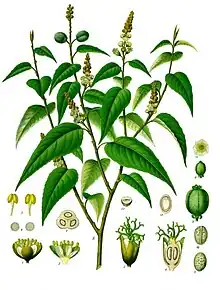Croton eluteria
Croton eluteria, known as cascarilla, is a plant species of the genus Croton that is native to the Caribbean. It has been naturalized in other tropical regions of the Americas. It grows to be a small tree or tall shrub, rarely reaching 20 feet (6 m) in height. Its leaves are scanty, alternate, ovate-lanceolate, averaging 2 inches (5 cm) long, with close scaling below, giving a metallic silver-bronze appearance, and scattered white scales above. The flowers are small, with white petals, and very fragrant, appearing in March and April. The scented bark is fissured, pale yellowish brown, and may be covered in lichen.[1]
| Croton eluteria | |
|---|---|
 | |
| Scientific classification | |
| Kingdom: | Plantae |
| Clade: | Tracheophytes |
| Clade: | Angiosperms |
| Clade: | Eudicots |
| Clade: | Rosids |
| Order: | Malpighiales |
| Family: | Euphorbiaceae |
| Genus: | Croton |
| Species: | C. eluteria |
| Binomial name | |
| Croton eluteria | |
Cascarilla bark is also used to flavor the liqueurs Campari and Vermouth.[2]
Chemical constituents
Cascarilla bark contains anything between 1% and 3% volatile oils, a unique series of diterpenoid compounds called cascarillins, lignins, tannin, and resins. There is also a long list of flavory terpene and diterpene compounds, including pinene, vanillin, D-limonene, and thujene.[3]
Uses
Croton eluteria is used as a fumigant and bitter stomachic.
References
- "A Modern Herbal | Cascarilla". Botanical.com. Retrieved 2020-10-07.
- "The Sweet Birthday of a Beloved Bitter". Saveur Magazine. Bonnier Corporation. Retrieved 10 May 2018.
- "Cascarilla - Croton eluteria Database File Database file in the Tropical Plant Database for herbal remedies". Rain-tree.com. Retrieved 2020-10-07.
External links
- . New International Encyclopedia. 1905.